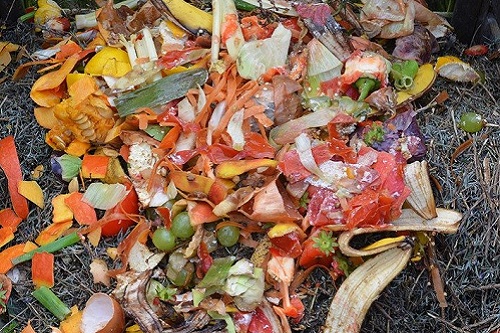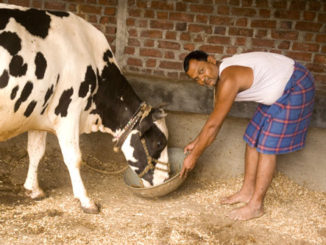Introduction
To meet the increasing global food demand, it is necessary both to increase the productivity and to use available resources more efficiently. Family farmers constitute approximately 60 % of the global agricultural production (FAO 2016). Around 98 % of farms in the world are family farms that are heavily dependent on natural resources for their subsistence (Bergeret et al. 2016). However, the scarcity of resources does not allow for increasing the agricultural production, leading to a vulnerability of the global population to food in security and hunger (FAO 2016).
Livestock play an integral role in the livelihood of poor farmers by providing economic, social and food security. In India a shortage of 25, 159 and 117 million tonnes of concentrates, green forages and crop residues, constituting respectively a shortage of 32, 20 and 25 percent of the requirement has been estimated (Ravi Kiran et al., 2012). The area under fodder production cannot be increased due to increasing human population and urbanization and the industrial intensive model of livestock production has severe limitations due to increasing cost of fossil fuels, competition for food-feed-fuel and other biophysical limiting factors.
The major constraint in the development of livestock sector is poor availability of nutrients (Sarwar et al., 2002). There is a need of 13.5 and 110.3 million tons of crude protein (CP) and total digestible nutrient (TDN), respectively (Anonymous, 2006) to fulfill the requirement of livestock therefore improvement in livestock demands the efficient use of available feed resources. Feed and fodder availability among Asian countries is not sufficient to meet even dry matter requirement of growing ruminant population, there is need to explore new feed resources which do not compete with human feed chain (Raghuvansi et al., 2007).
Alternate feed resources
1. Sugarcane trash
Sugar cane dry trash and is a part of sugar cane tops and is a major byproduct of the sugarcane industry which is left in the field after sugar cane harvest. The major states producing sugarcane are UP, Maharashtra, Karnataka, Tamil Nadu, Andhra Pradesh, Telangana, Bihar, Gujarat, Haryana, Uttarakhand and Punjab. With a cane to dry leaf ratio oalternate feed resourcesf 2-3 %, about 6.8-10.3 million tonnes of sugar cane trash is expected to be available at the time of harvest in India. The trash can be fed to livestock as a replacement of dry fodder like paddy straw or finger millet straw in situations of drought. Sugarcane trash is good source of fiber (NDF: 32.3%), and hemi-cellulose (26.9%). Sugarcane trash is very bulky material and occupies lot of space. This can be a major drawback during transportation. This can be avoided if trash is chaffed to small pieces with the help of mechanical chaff cutter (4-6 inches).
2. Sugar cane crop
Some time due to surplus sugar cane production, lock down situations, labor shortage and closure of sugar factories, whole sugar cane plant is available to use as fodder resource. The whole plant should be chaffed and use along with other dry fodder. Its nutritive value is similar to maize green fodder. Care should be taken to avoid rumen acidosis and it should not be fed as a sole fodder (Rao et al., 2019a).
3. Sunflower heads
Sunflower head is a residue after extraction of seeds. Crushed sunflower head has a crude protein content of 7-10%, fibre- 45-50% and dry matter digestibility of 50-55%. It can be included in total mixed ration upto 40% as roughage source (Gowda and Anandan, 2019)
4. Maize stover and Cobs
Maize crop is being cultivated on a large scale due to the high demand for maize grains for feed, starch industry and distilleries. Stover and cobs can be used as roughage source in diets of cattle, buffalo, sheep and goats. Maize stovers in general after harvesting the cobs are either left in the field itself or sometimes burnt in the field to make way for the next crop. The nutritive value is almost similar to any cereal dry fodder. The cobs can be shredded and compressed into blocks for easy transportation (Rao et al., 2019).
5. Haulms of Groundnut and Horse gram
The leafy residues of ground nut and horse gram (top feeds) are leguminous in nature and has better protein and digestible fibre value as compared to cereal dry fodders (Gowda and Anandan, 2019). Ruminant animals, particularly sheep and goat relish them very much. These top feeds can be dried and stacked to use as dry fodder in case of dry fodder shortage.
6. Fruit and vegetable residues
In many Asian countries, there is a gradual shift in the cropping pattern from cereals to more remunerative fruit and horticultural crops. This results in generation of huge quantity of fruit and vegetable residues. There is a need to develop suitable methods to convert waste to wealth and contribute to value added feed resources (Bakshi and Wadhwa, 2013). Some of the potential fruit residues that can be used in feeding are reviewed (Wadhwa and Bakshi, 2013).

A) Grapes
Grape pomace is a by-product of wine industry comprising grape pulp, skin, stem and seeds accounting about 20% of the grape fruit. The annual production is about 1.6 million tonnes and limited quantity is processed for wine. On dry matter basis, grape pomace contains 11% crude protein, 27% crude fiber and 5% lignin. Due to lignified fiber, the digestibility and energy value is low. The dried pomace has phenolic anti-oxidant compounds. Due to lower nutritive value grape pomace can be used in smaller quantity in ruminants feeding.
B) Apple
In India annually about 1.74 million tonne of apple is produced and waste consists of peels, seed and pulp, which represents 25-35% of fresh apple. The apple pomace on dry matter basis consists of 4.72% crude protein and 48-60% total sugar. It is a good source of energy (75% TDN) and can replace 30% maize grain in ruminant ration. The residue contains high moisture and can be dried in sunlight or at 65% moisture level can be made as silage for preservation to use as feed.
C) Mango
Majority of the mango is consumed freshly and only about 2% is processed and generates 40-50% waste. The waste includes peels, juice extraction waste, seeds and kernel. The seed kernel represents about 50% of the whole seed and contains 7-12% oil and 40% starch on dry matter basis. Boiling and autoclaving will remove certain anti-nutritional factors like cyanognic glycosides, oxalate and trypsin inhibitors also protein content of mango seed kernel is low.
D) Citrus fruit by-products
About 40-50% waste is generated from citrus juice industry and contains soluble sugars. It can be made as silage along with dry fodder and used as cattle feed.
E) Banana fruit by-product
The banana fruit waste like peels contains more moisture, low protein and more soluble sugars.
F) Jack fruit residue
Jack fruit is a common horticultural crop in many Asian and African regions. In India about 1.2 million tones of jack fruit is produced leaving a residue of 0.8 million tonnes per year. This residue (skin, aerial parts) is inedible for human consumption and quickly putrefies due to high sugar and moisture content. Jack fruit residue contains crude protein (6-7% on DM basis), total sugars (60-65% on DM basis) and higher organic matter digestibility (70-78%). It is palatable and can be fed to ruminants as fodder source along with supplementary nitrogen (urea/tree leaves/ oil cake) (Kusmartono, 2007).
G) Tomato Pomace
India ranks second in the world in tomato production contributing 10.82% of world production. Tomato pomace is major by-product of tomato processing industries. Sun-drying or artificial drying is the preferred method and resultant product is crispy and it can be mixed along with other feeds and use as roughage source.
H) Pineapple fruit residue
The residue includes leafy crown, peels and the pomace of juice extraction. The pineapple fruit residue on dry matter basis contains 6-7% crude protein, 50% total sugar, and 70% energy (TDN). The residue can be chaffed and dried to less than 10% moisture and use as hay. Otherwise, after draining the excess moisture, the waste can be made as silage and can be used as a fodder source for cattle / sheep.
7. Hydroponic grain sprouts
Producing the green feed through germination of grains like maize, barley, oat or wheat produces consistent quantities of green feed throughout the year at the rate of about 4 to 6 kg/ kg of seed within 10 days period. It is essentially a hydroponic technique, where the sprouted seeds spread over the trays grow into green feed in a 10 day cycle (Muthuramalingam et al., 2015). Soaking the seeds with 4% vinegar solution is quite effective in preventing mold growth (Giridhar et al., 2019).
8. Azolla
Azolla (A. Pinnata, A. nilotica,) a water floating fern and triangular in appearance, consisting of roots, stems (rhyzomes) and leaves. Azolla grows in symbiotic association with a blue- green alga Anabaena azollae, a nitrogen fixing organism. Azolla is a protein rich green feed, leucine, lysine, arginine and valine are the predominant amino acids in Azolla, while tryptophan and sulfur containing amino acids are deficient. Azolla is also rich in vitamin A, vitamin B12, Beta carotene, growth promoting intermediaries, bioactive compounds and bio-polymers and azolla is well digested by livestock (Indira et al., 2009). Azolla can be used as a valuable green feed protein supplement mixed with crushed maize grain or wheat / rice bran. This is very useful under low input livestock production system (Gowda et al., 2015).
9. Fodder Trees
Providing top feeds from the trees will help to bridge the deficit of green fodder. In dry regions, their utility is much more realized. Trees like Sesbania, Subabul, Gliricidia, Melia etc. perform well even in dry lands (Garg and Digvijay Singh, 2011). Most of the tree leaves have a protein content of 18-20%, fibre content of 30-35% and calcium content of 1-2%. Tree leaves can be fed to meet 10-15% of total protein requirement. Besides, most trees leave possess tannins and can be a good source for methane mitigation in ruminant diets (Sharma et al., 2016).
L) Hotel food and kitchen waste
It is a rural house hold practice to feed left over edible food and vegetable in domestic kitchen to their cattle. Wadhwa and Bakshi (2013) have reviewed the prospects of using vegetable waste as animal feed. Disposal of food waste generated by hotel industries is an enormous challenge. There is enormous opportunity for utilizing these wastes as feed for livestock. The vegetable and vegetarian food wastes can be fed to dairy animals along with other concentrates and roughages. However, the wastes need to be cooked or heat treated or microbiologically treated before offering to cattle to ensure that they are bacteria free and edible.
Conclusion
Strategies for strengthening the feed/ fodder base should focus on regional availability and suitability of potential resources. A major drawback in the use of the nontraditional oil seeds is lack of appropriate processing methods that are not only effective to neutralizing the toxins but are economical and simple enough to be taken up by the processing industries. Perception of end users about the technology and their involvement in technology validation is a key to its successful adoption. Krishi Vigyana Kendra’s, Organized Livestock Farms and village level self-help groups should act as sub-centers of technology transfer and harness benefits of these innovations.
References
- Anonymous. 2006. Economic survey, Government of Pakistan, finance division, Islamabad , Pakistan .
- Bakshi, M.P.S. and Wadhwa, M. 2013. Nutritional evaluation of cannery and fruit wastes as livestock feed. Indian J. .Ani. Sci. 83(11): 1198-1202.
- Baumer, M. 1992. Trees as browse to support animal production. In A. Speedy & P.-L. Pugliese, eds. Legume trees and other fodder trees as protein sources for livestock. Proceedings of an FAO Expert Consultation, Kuala Lumpur, Malaysia, p. 1-10. Rome, FAO.
- Bergeret, P. et al. 2016. Family farming for enhancing knowledges and human resources. Paris: Presses de Sciences,
- Devendra, C. (ed.) 1989. Introduction of shrubs and tree fodders for farm animals. IRDC, Canada.
- Giridhar, K., Gowda, N.K.S. and Anandan, S. 2019. Farmer friendly green fodder production technologies. In : Compendium of Regional workshop on “Sustainable livestock production in doubling the farmers income” 11-12, July 2019 organised by ANSI at SVVU, Tirupati, PP 67-72.
- Gowda, N.K.S. and Anandan, S. 2019. Yelgod S G (Edited) Approaches to improve fodder availability for livestock. In: Compendium of Techncial seminar of KVA at GKVK, UAS, Bangalore, 20-21July 2019.24-30.
- Gowda, N.K.S., Manegar, A, Verma S, Vallesha, N.C. Maya, G., Pal, D.T. and Suresh, K.P. 2015. Azolla (Azolla pinnata) as a green feed supplement for dairy cattle –An of farm study. Ani. Nutri. Feed Tech. 15: 283-287.
- Indira, D., Sarjan Rao, K., Suresh, J., Venugopal Naidu, K and Ravi, A. 2009. Azolla (A. pinnata) as feed supplement in buffalo calves on growth performance. Indian J. Ani.Nutri. 26(4): 345-348.
- Kusmartono. 2007. Effects of supplementing jack fruit wastes with urea or gliricidia / cassava leaves on growth, rumen digestion and feed degradability of sheep fed on rice straw basal diet. Livestock Res. Rural Development. 19(2): 1-11.
- Muthuramalingam, T., Pothiappan, P., Tensingh Gnanaraj, P., Meenakshi Sundaram, S. and Pugazhenthi, T.R. 2015. Studies on growth performance of goats fedhydroponic maize fodder. Indian Vet. J. 92(4):94-96.
- Raghuvansi, S.K.S., Prasad, R., Mishra,A.S., Chaturvedi,O.H., Tripathi M,K., Misra A.K., Saraswat B.L., and Jakhmola, R.C., 2007: Effect of inclusion of tree leaves in feed on nutrient utilization and rumen fermentation in sheep. Biores. Technol., 98: 511-517.
- Rao, S.B.N. Gowda, N.K.S., Soren, N.M., Pavan Kumar, M.A., Awachat, V.B., Karthik Bhat, S., Prasad, K.S. and Ramachandra, K.S. 2019a. Nutritional evaluation of sugar cane trash as dry fodder source for cattle. Indian J. Ani. Sci. 89(6): 667-670.
- Rao, S.B.N., Gowda, N,K,S,, Anandan, S.and Prasad, K.S. 2019. Potential of unconventional feed resources for livestock feeding. In : Compendium of Regional workshop on “ Sustainable livestock production in doubling the farmers income” 11-12, July 2019 organised by ANSI at SVVU, Tirupati,pp. 56-62.
- Ravi Kiran, G., Suresh, K.P., Sampath, K.T., Giridhar, K. & Anandan, S. 2012. Modeling and Forecasting Livestock and Fish Feed Resources: Requirements and Availability in India, National Institute of Animal Nutrition and Physiology, Bangalore.
- Sarwar, M., Khan, M.A., and Iqbal. Z., 2002: Feed resources for livestock in Pakistan. International J. Agri. Biol. 1:186.
- Sharma, R.K., Rastogi, A. and Haq, Z. 2016. Top feeds for sustainable and ecofriendly small ruminant production. In: Dutta,N., Jadhav, S.E., Kala, A., Gopi, M., & Ramana, J.V. (Eds.), Newer perspectives in Animal Nutrition Research for Augmenting Animal Productivity, pp 22- 35, Proceedings of X Biennial Animal Nutrition Association Conference, 9-11 November, 2018, Tirupati.
- Wadhwa, M. and Bakshi, M.P.S. 2013. Utilization of fruit and vegetable wastes as livestock feed and as substrates for generation of other value-added products. RAP Publication 2013/04, FAO 2013, (Ed), H.P.S. Makkar.






Be the first to comment